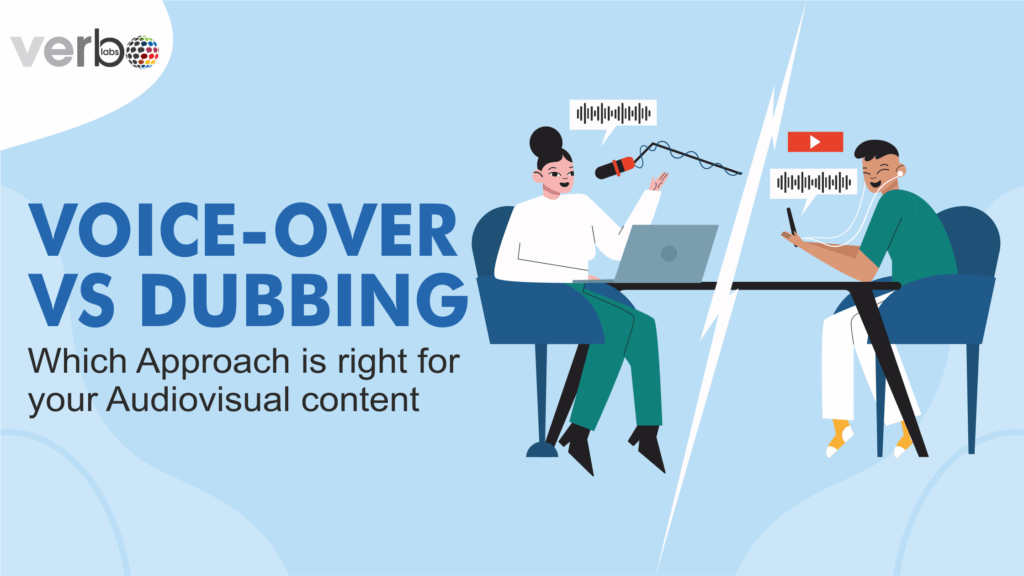Audiovisual content consumer of the current era has widened their scope of consuming content beyond the borders of language and nationality. With the help of Voice-Over and Dubbing, everyone can consume all kinds of audiovisual content. Voice-over and Dubbing enable content providers to reach a larger international audience by translating and modifying their work into various languages. But, any content creator or business who wants to get a global audience must choose between Voice-Over and Dubbing.
Factors to consider when choosing between voice-over and Dubbing
- Audience preferences: Study the importance of your intended audience whether they like to consume content with subtitles or dubbed audio.
- Localization requirements: Consider the degree of localization required for your material when determining its requirements. Dubbing guarantees a flawless viewing experience, whereas voice-over offers more freedom in adaptation.
- Visual context: Evaluate the role of lip-syncing in delivering the desired message and the visibility of the original actors.
- Budget and resources: Consider the cost and accessibility of expert voice actors or dubbing studios.
- Project timeline: Dubbing, with its need for lip-sync accuracy, often demands more time and effort than Voice-Over. An AI voice cloning tool can mitigate these challenges by providing quick and cost-effective dubbing solutions.
Voice-Over
The process of recording spoken narration or conversation without accompanying on-screen visuals is referred to as voice-over. It is frequently employed in various media projects, including movies, television programmes, advertisements, documentaries, video games, and audio recordings. Voice-over is commonly used in productions to explain visual components, narrate a story, or provide supplementary information. It can narrate audiobooks, provide commentary in documentaries, give characters their voices in animated movies or video games, convey promotional messages in advertisements, and more. Voice-over artists develop various characters and express emotions and the desired message using their vocal abilities.
When to employ Voice-Over for your Audiovisual Content?
Knowing when to use voice-over instead of dubbing in your media project is critical. Your project’s requirements, objectives and intended audience should all be considered while deciding whether to use voice-over for audiovisual content or not. Voice-over can enhance storytelling, offer clarity, engage the viewer, and give your content an air of elegance. Let’s find out which audiovisual content needs Voice-Over services.
- Voice-Over is frequently used for narration purposes. In this scenario, a narrator provides commentary, background information, or storytelling throughout the content.
- Voice-over services are employed to create a unique voice in animated movies, cartoons, and video games. The artists lend their voices to various characters and bring them to life.
- On-screen, when some voice is heard, but the speaker can’t be seen, in such situations voice-over is used. Examples of such cases can be a phone conversation, inner thoughts, or radio broadcasting in a scene.
- Essential details, explanations, or directions can be conveyed inside the content via voice-over. This is frequently observed in instructional videos, training videos, or educational materials where the voice-over performer gives detailed instructions or imparts knowledge.
- Voice-over is frequently utilized when content needs to be translated or localized for audiences that speak different languages by keeping the original graphics while translating the dialogue to the target language.
- Voice-over is widely employed in commercials and advertisements to convey persuasive messages, to advertise goods or services, or to narrate narrative aspects.
Dubbing
Dubbing translates the original dialogue from a movie, television programme, or other audiovisual work into a new language. To ensure a smooth watching experience, the conversation must be recorded in the chosen language and synchronized with the lip movements of the actors. Dubbing is done by a group of voice actors known as dubbing artists. It is frequently employed to make audiovisual content available to viewers who might need help comprehending the original language. It permits them to enjoy the content in their native language without relying on subtitles.
When to employ Dubbing for your Audiovisual Content?
Consider your project’s target audience, cultural setting, and distribution objectives while deciding whether to use Dubbing for your audiovisual content or not. Budget, resource, and time limits should also be considered because Dubbing takes competent translation, talented voice artists, and accurate synchronization to provide high-quality results. Dubbing can be used in several scenarios for enhancing the reach of your audiovisual work. Here are some typical instances that require dubbing:
- Dubbing enables localization and linguistic adaptation when distributing content to worldwide markets. For viewers who might not understand the original language, the conversation is dubbed into the target language to make it more relatable and accessible.
- When trying to reach a large audience, Dubbing can be helpful, especially in areas or nations with a strong preference for seeing media in their native tongue. Subtitles are unnecessary with dubbed content, giving viewers a more immersive and seamless viewing experience.
- Dubbing enables cultural adaption of the content by translating not only the conversation but also cultural allusions, humor, and idioms to make them relevant and relatable to the target audience. By doing this, the original content’s context, cultural references, and intended spirit are preserved.
- By giving an audible description of the visual components and on-screen actions, Dubbing can also help viewers with vision difficulties. This improves accessibility and makes audiovisual content more accessible to those who are blind.
Conclusion
You can use voice-over or Dubbing depending on your content, target audience, spending limit, and localization needs. Regional tastes and business standards also have an impact. Consider the resources mentioned above to decide between Voice-Over and Dubbing. You can hire Verbolabs to provide excellent voice-over and dubbing services for your business.



